Quantitative Analysis of Groundwater Recharge in an Arid Area, Northwest China
Abstract
:1. Introduction
2. Methods and Materials
2.1. Samples and Test Data
2.2. Research Method
3. Hydrological and Hydrogeological Characteristics of the Study Area
4. The Hydrodynamic Characteristics of the Unconfined and Confined Groundwater
5. Isotopic Temporal and Spatial Distributions of Unconfined Groundwater and Confined Water
6. Construction of the Quantitative Groundwater Circulation Model by MCM
6.1. Construction of a Conceptual Model of Groundwater Flow Unconfined Groundwater
6.2. Mixing Cell Model Construction
6.3. Analysis of the Modeling Results and Construction of the Quantitative Water Circulation Model
7. Conclusions
Acknowledgments
Author Contributions
Conflicts of Interest
References
- Reynolds, J.F.; Stafford Smith, D.M.; Lambin, E.F.; Turner, B.L.; Mortimore, M.; Batterbury, S.P.J.; Downing, T.E.; Dowlatabadi, H.; Fernandez, R.J.; Herrick, J.E.; et al. Global desertification: Building a science for dryland development. Science 2007, 316, 847–851. [Google Scholar] [CrossRef] [PubMed]
- Wang, L.; Li, G.; Dong, Y.; Han, D.; Zhang, J. Using hydrochemical and isotopic data to determine sources of recharge and groundwater evolution in an arid region: A case study in the upper-middle reaches of the Shule River basin, northwestern China. Environ. Earth Sci. 2014, 73, 1901–1915. [Google Scholar] [CrossRef]
- Mayzelle, M.M.; Viers, J.H.; Medellin-Azuara, J.; Harter, T. Economic feasibility of irrigated agricultural land use buffers to reduce groundwater nitrate in rural drinking water sources. Water 2015, 7, 12–37. [Google Scholar] [CrossRef]
- Fugang, W. The Application of Isotope Techniques in the Hydrological Cycle of Overground Section (Henan Section) of the Lower Reaches of Yellow River. Ph.D. Thesis, Jilin University, Changchun, China, 2006. [Google Scholar]
- Klaus, J.; Külls, C.; Dahan, O. Evaluating the recharge mechanism of the Lower Kuiseb Dune area using mixing cell modeling and residence time data. J. Hydrol. 2008, 358, 304–316. [Google Scholar] [CrossRef]
- Dahan, O.; McGraw, D.; Adar, E.; Pohll, G.; Bohm, B.; Thomas, J. Multi-variable mixing cell model as a calibration and validation tool for hydrogeologic groundwater modeling. J. Hydrol. 2004, 293, 115–136. [Google Scholar] [CrossRef]
- Marques, J.M.; Eggenkamp, H.G.M.; Graca, H.; Carreira, P.M.; Matias, M.J.; Mayer, B.; Nunes, D. Assessment of recharge and flowpaths in a limestone thermomineral aquifer system using environmental isotope tracers (Central Portugal). Isot. Environ. Health Stud. 2010, 46, 156–165. [Google Scholar] [CrossRef] [PubMed]
- Hagedorn, B. Hydrochemical and 14 C constraints on groundwater recharge and interbasin flow in an arid watershed: Tule Desert, Nevada. J. Hydrol. 2015, 523, 297–308. [Google Scholar] [CrossRef]
- Yang, Q.; Xiao, H.L.; Zhao, L.J.; Yang, Y.G.; Li, C.Z.; Zhao, L.A.; Yin, L. Hydrological and isotopic characterization of river water, groundwater, and groundwater recharge in the heihe river basin, northwestern china. Hydrol. Process. 2011, 25, 1271–1283. [Google Scholar] [CrossRef]
- Cook, P.G.; Herczeg, A.L. Environmental Tracers in Subsurface Hydrology; Springer Science & Business Media: New York, NY, USA, 2012. [Google Scholar]
- Eastoe, C.J.; Rodney, R. Isotopes as tracers of water origin in and near a regional carbonate aquifer: The southern Sacramento Mountains, New Mexico. Water 2014, 6, 301–323. [Google Scholar] [CrossRef]
- Kebede, S.; Travi, Y.; Alemayehu, T.; Ayenew, T. Groundwater recharge, circulation and geochemical evolution in the source region of the Blue Nile River, Ethiopia. Appl. Geochem. 2005, 20, 1658–1676. [Google Scholar] [CrossRef]
- Zhu, C. Estimate of recharge from radiocarbon dating of groundwater and numerical flow and transport modeling. Water Resour. Res. 2000, 36, 2607–2620. [Google Scholar] [CrossRef]
- Davisson, M.; Smith, D.; Kenneally, J.; Rose, T. Isotope hydrology of southern nevada groundwater: Stable isotopes and radiocarbon. Water Resour. Res. 1999, 35, 279–294. [Google Scholar] [CrossRef]
- Gibson, J.; Edwards, T.; Birks, S.; St Amour, N.; Buhay, W.; McEachern, P.; Wolfe, B.; Peters, D. Progress in isotope tracer hydrology in Canada. Hydrol. Process. 2005, 19, 303–327. [Google Scholar] [CrossRef]
- Viville, D.; Ladouche, B.; Bariac, T. Isotope hydrological study of mean transit time in the granitic strengbach catchment (Vosges massif, France): Application of the FlowPC model with modified input function. Hydrol. Process. 2006, 20, 1737–1751. [Google Scholar] [CrossRef]
- Clark, J.F.; Stute, M.; Schlosser, P.; Drenkard, S.; Bonani, G. A tracer study of the Floridan aquifer in southeastern Georgia: Implications for groundwater flow and paleoclimate. Water Resour. Res. 1997, 33, 281–289. [Google Scholar] [CrossRef]
- Ofterdinger, U.; Balderer, W.; Loew, S.; Renard, P. Environmental isotopes as indicators for ground water recharge to fractured granite. Ground Water 2004, 42, 868–879. [Google Scholar] [PubMed]
- Weyhenmeyer, C.E.; Burns, S.J.; Waber, H.N.; Macumber, P.G.; Matter, A. Isotope study of moisture sources, recharge areas, and groundwater flow paths within the eastern Batinah coastal plain, Sultanate of Oman. Water Resour. Res. 2002, 38, 2-1–2-22. [Google Scholar] [CrossRef]
- Pang, Z. Isotope and chemical geothermometry and its applications. Sci. China Ser. E Technol. Sci. 2001, 44, 16–20. [Google Scholar] [CrossRef]
- Adar, E.M.; Nativ, R. Use of hydrochemistry and isotopes in a mixing-cell model to quantify the relative contribution of multiple-source contaminants to seepage from a fractured chalk aquitard. In Proceedings of the TraM’2000 Conference, Liège, Belgium, May 2000; pp. 315–320.
- Adar, E.M.; Neuman, S.P.; Woolhiser, D.A. Estimation of spatial recharge distribution using environmental isotopes and hydrochemical data, I. Mathematical model and application to synthetic data. J. Hydrol. 1988, 97, 251–277. [Google Scholar] [CrossRef]
- Adar, E.M.; Neuman, S.P. Estimation of spatial recharge distribution using environmental isotopes and hydrochemical data, II. Application to aravaipa valley in southern arizona, USA. J. Hydrol. 1988, 97, 279–302. [Google Scholar] [CrossRef]
- Fraser, C.; Roulet, N.; Lafleur, M. Groundwater flow patterns in a large peatland. J. Hydrol. 2001, 246, 142–154. [Google Scholar] [CrossRef]
- Partington, D.; Brunner, P.; Simmons, C.T.; Therrien, R.; Werner, A.D.; Dandy, G.C.; Maier, H.R. A hydraulic mixing−cell method to quantify the groundwater component of streamflow within spatially distributed fully integrated surface water–groundwater flow models. Environ. Model. Softw. 2011, 26, 886–898. [Google Scholar] [CrossRef]
- Brouyère, S.; Orban, P.; Wildemeersch, S.; Couturier, J.; Gardin, N.; Dassargues, A. The hybrid finite element mixing cell method: A new flexible method for modelling mine ground water problems. Mine Water Environ. 2009, 28, 102–114. [Google Scholar] [CrossRef]
- Schubert, M.; Scholten, J.; Schmidt, A.; Comanducci, J.F.; Pham, M.K.; Mallast, U.; Knoeller, K. Submarine groundwater discharge at a single spot location: Evaluation of different detection approaches. Water 2014, 6, 584–601. [Google Scholar] [CrossRef]
- Dongyan, G. Study of Groundwater Circulation Mechanism in Ling Wu Daquan Area. Master’s Thesis, Jilin University, Changchun, China, 2012. [Google Scholar]
- Tianhei, G. Probe into underground water fluorine enrichment and distribution pattern in Mianzishan Foreland, Lingwu. Coal Geol. China 2009, 11, 017. [Google Scholar]
- Xirong, H.; Guisheng, X. The characteristics of petrography and quality and geological interpretation of coal of yanan formation in lingwu coalfield. Coal Geol. China 1999, 2, 004. [Google Scholar]
- Huiming, Y. A Constitute Ananlysis of Groundwater Resources in Lingwu Daquan. Master’s Thesis, China University of Geosciences (Beijing), Beijing, China, 2011. [Google Scholar]
- Xiaosi, S.; Xueyu, L.; Zisheng, L.; Jinsheng, W. Variation of isotopes in the Yellow River along the flow path and its affecting factors. Geochimica 2003, 32, 349–357. [Google Scholar]
- Jun, L. Environmental Isotope Trace of Groundwater in Yinchuan Plain. Master’s Thesis, Changan’s University, Xi’an, China, 2007. [Google Scholar]
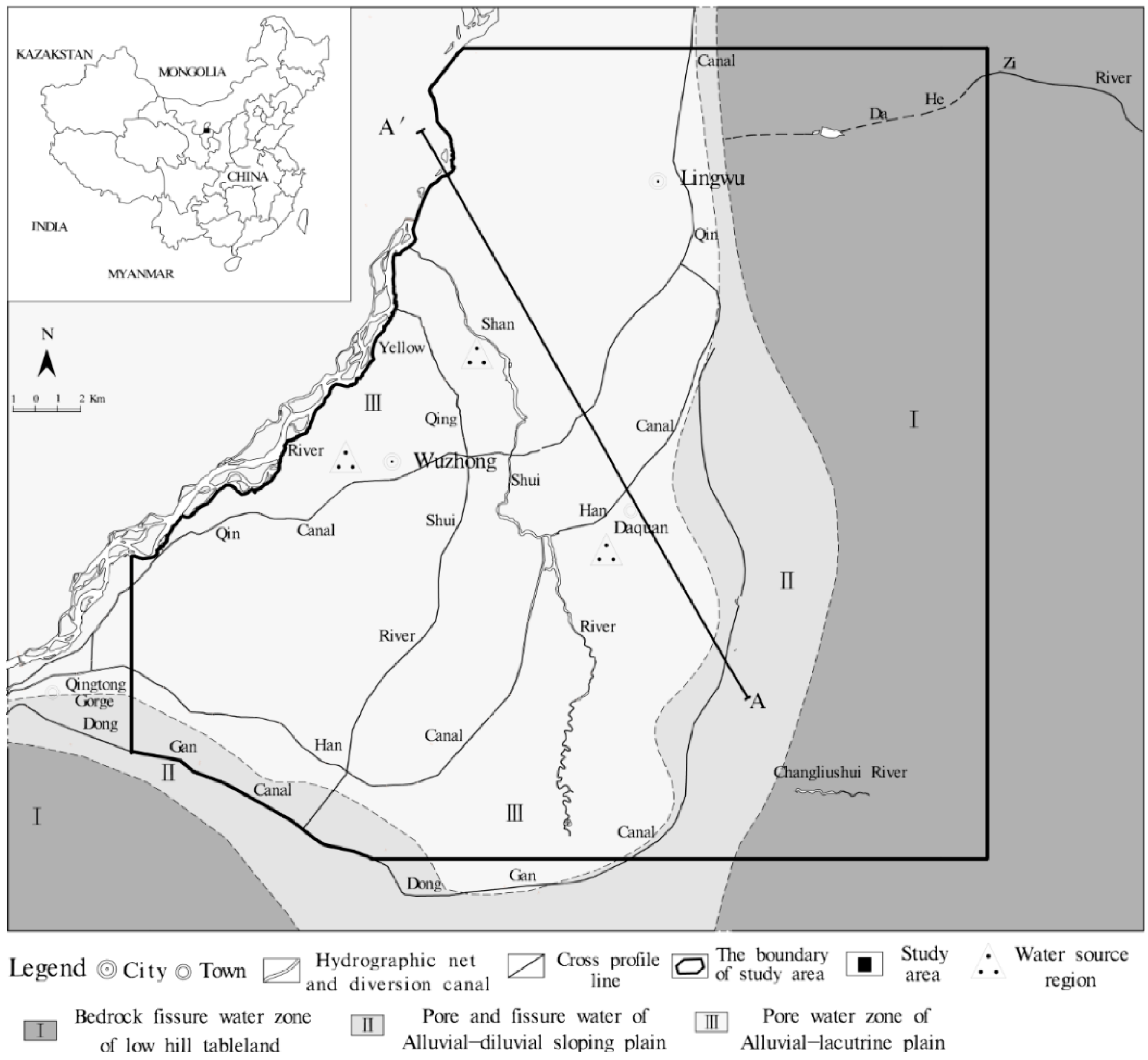
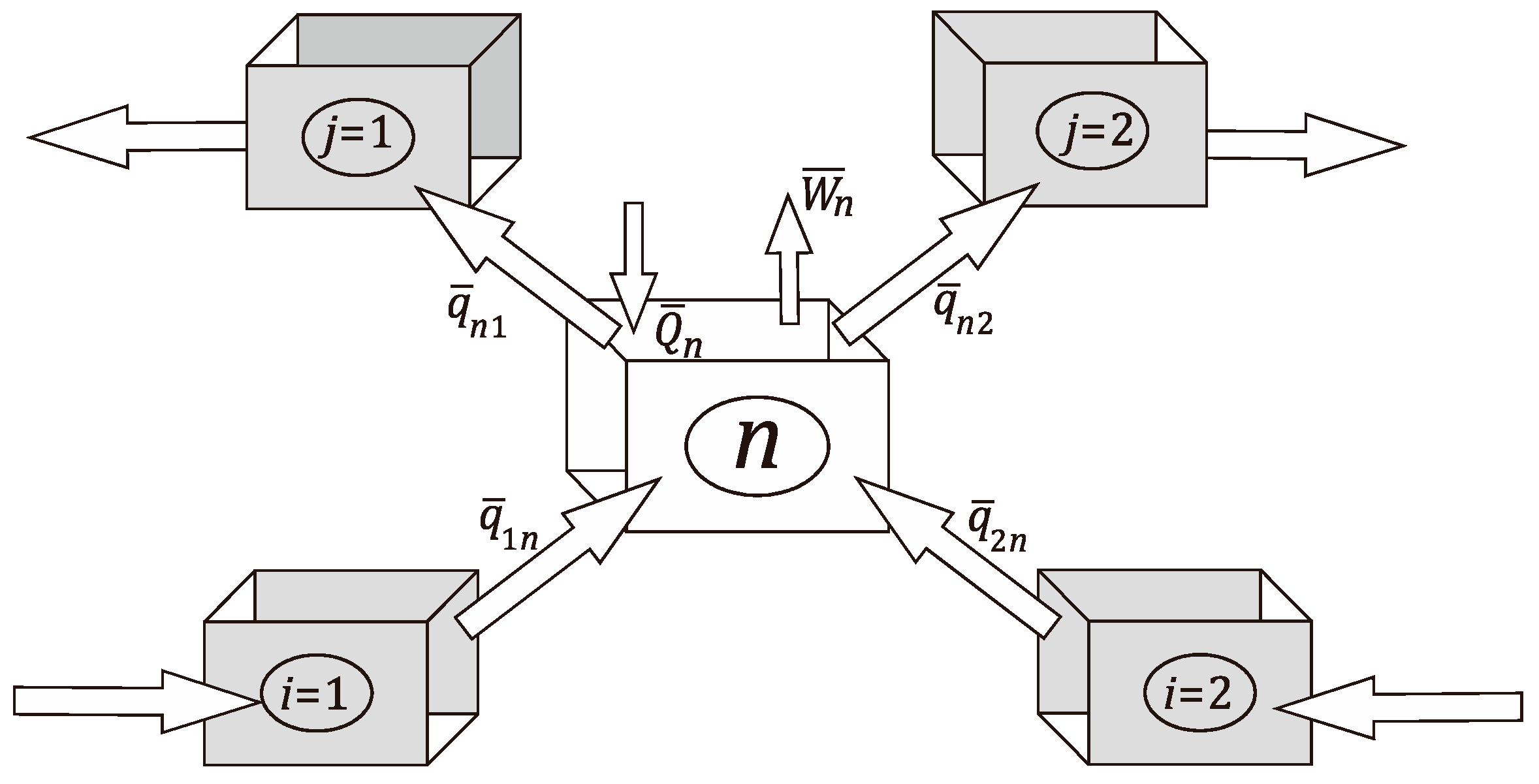


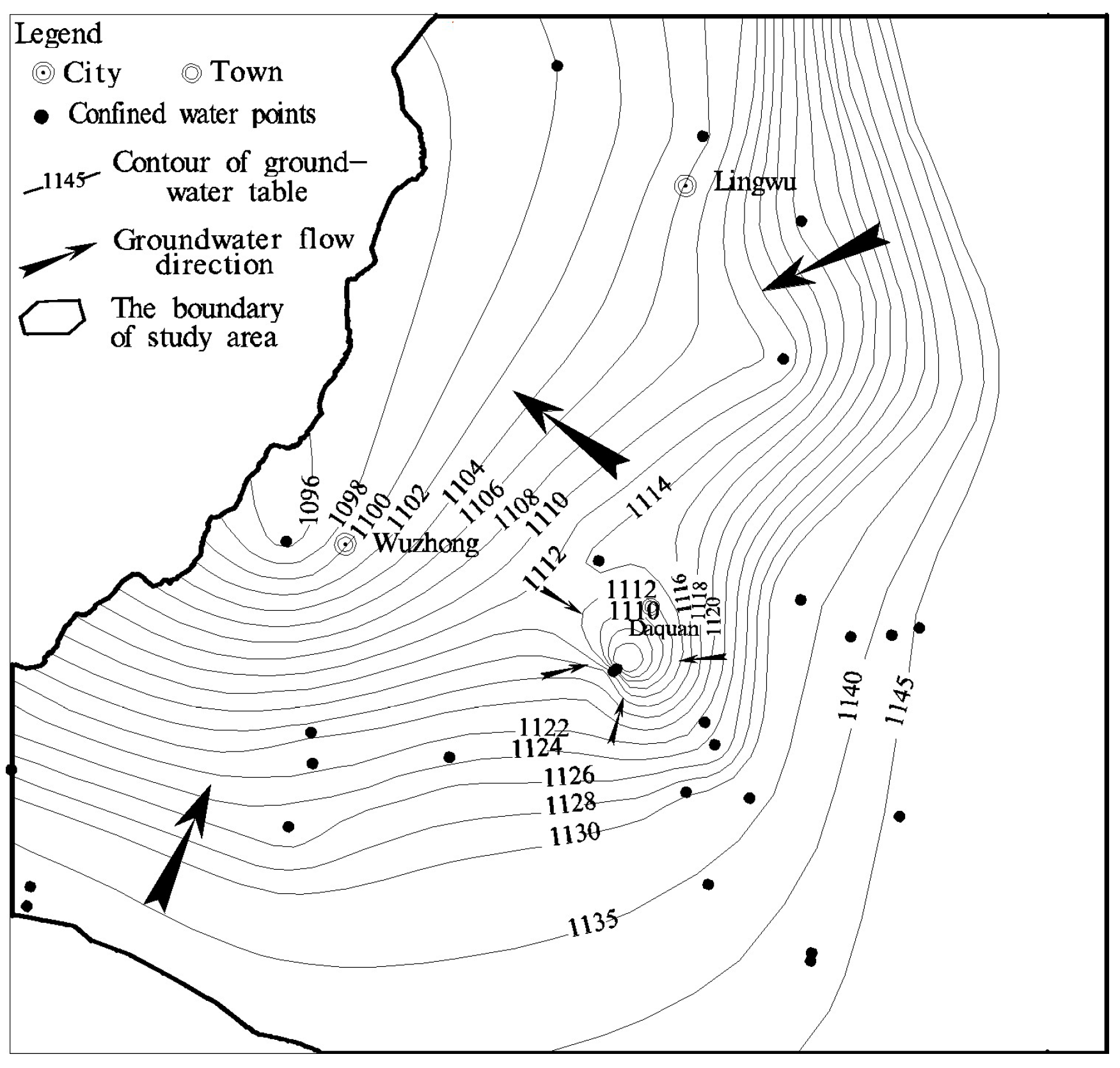


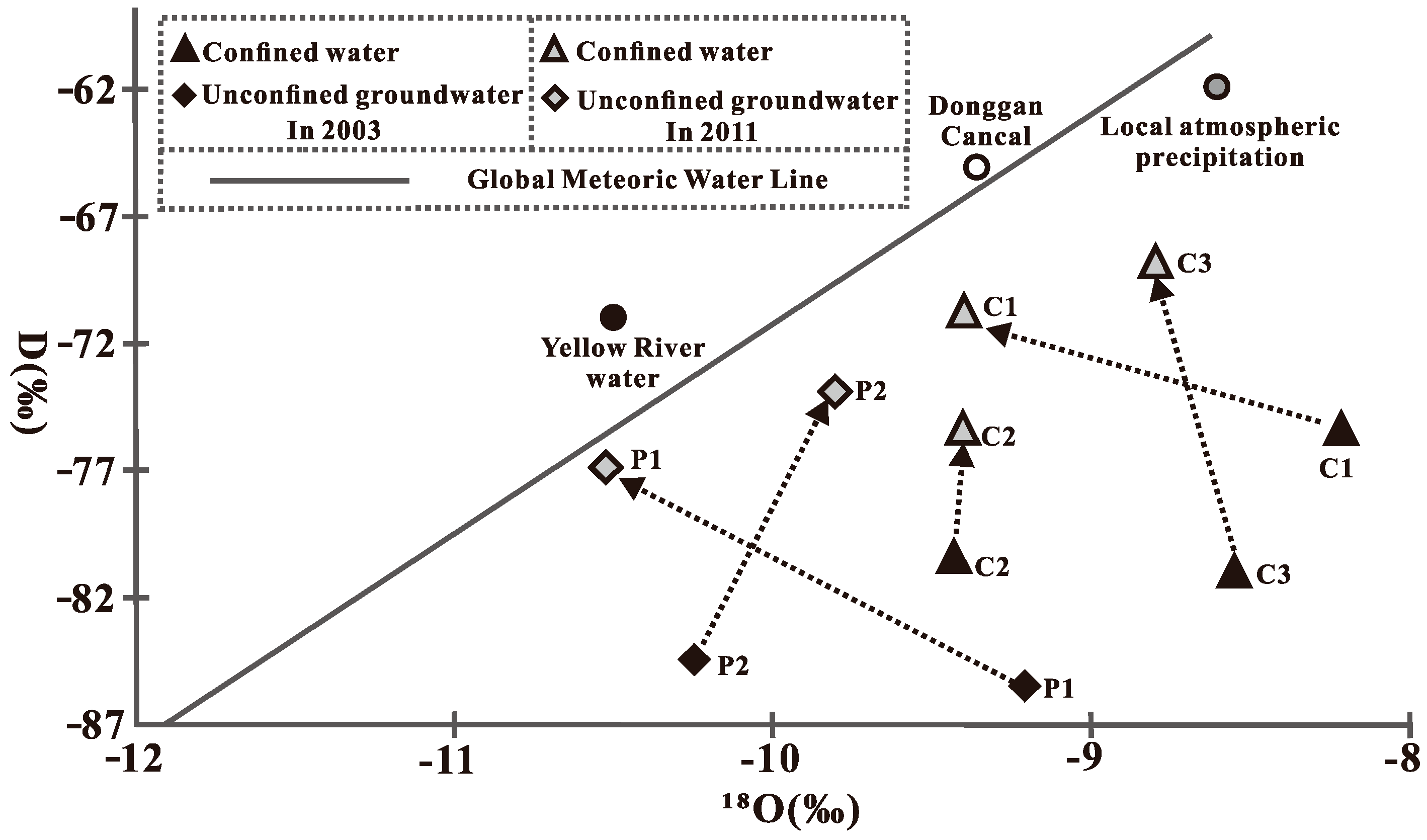
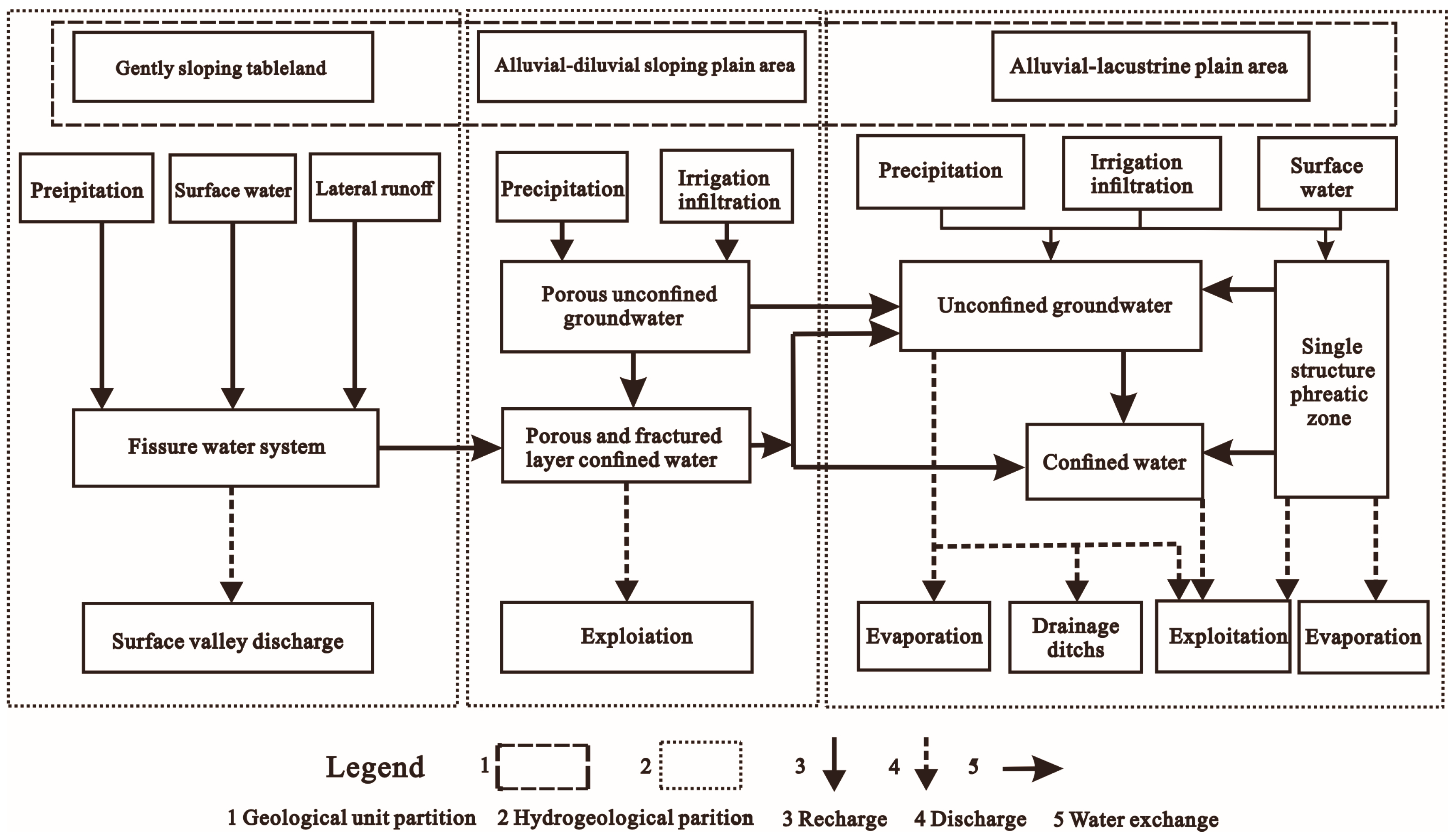
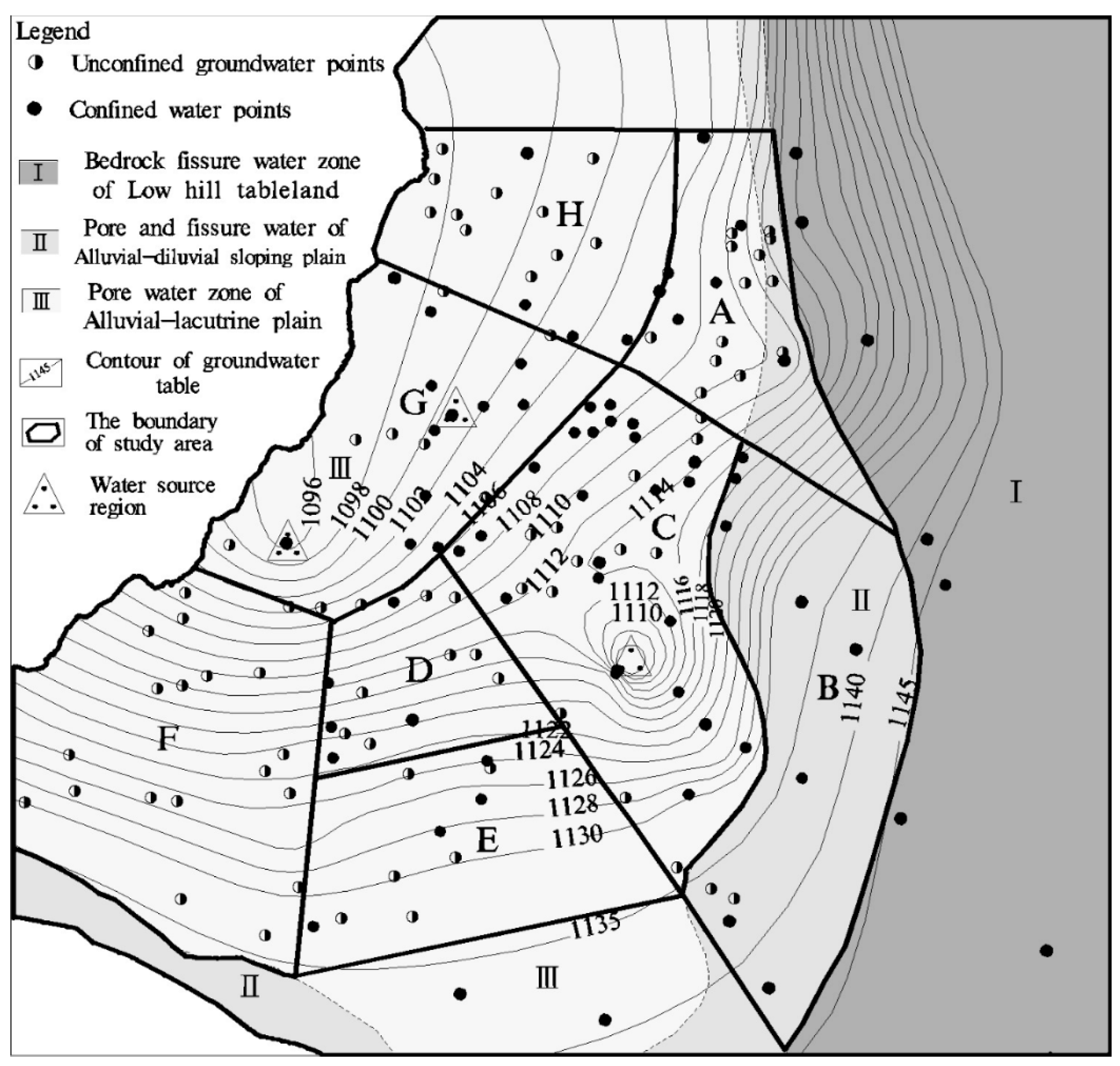
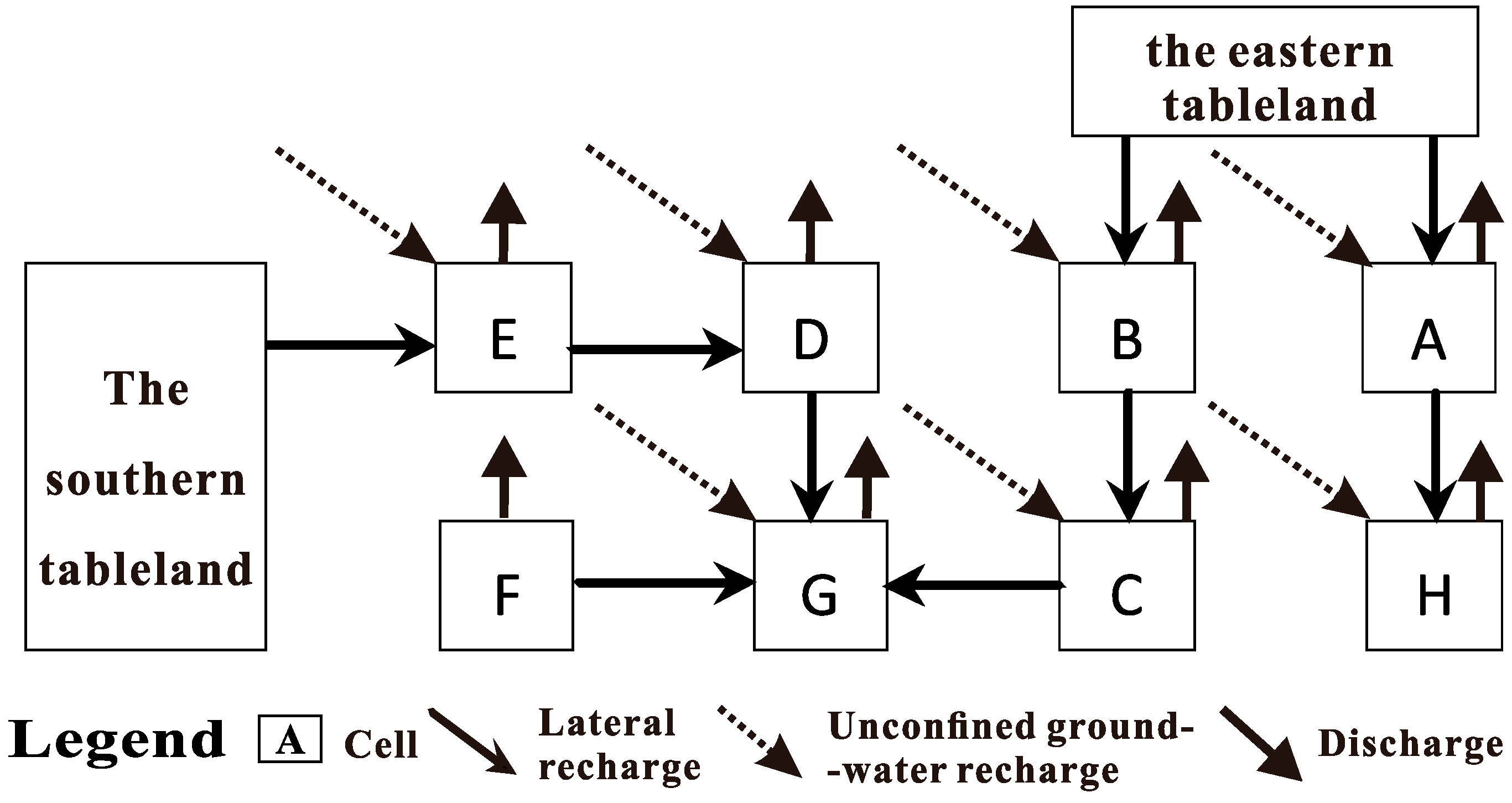
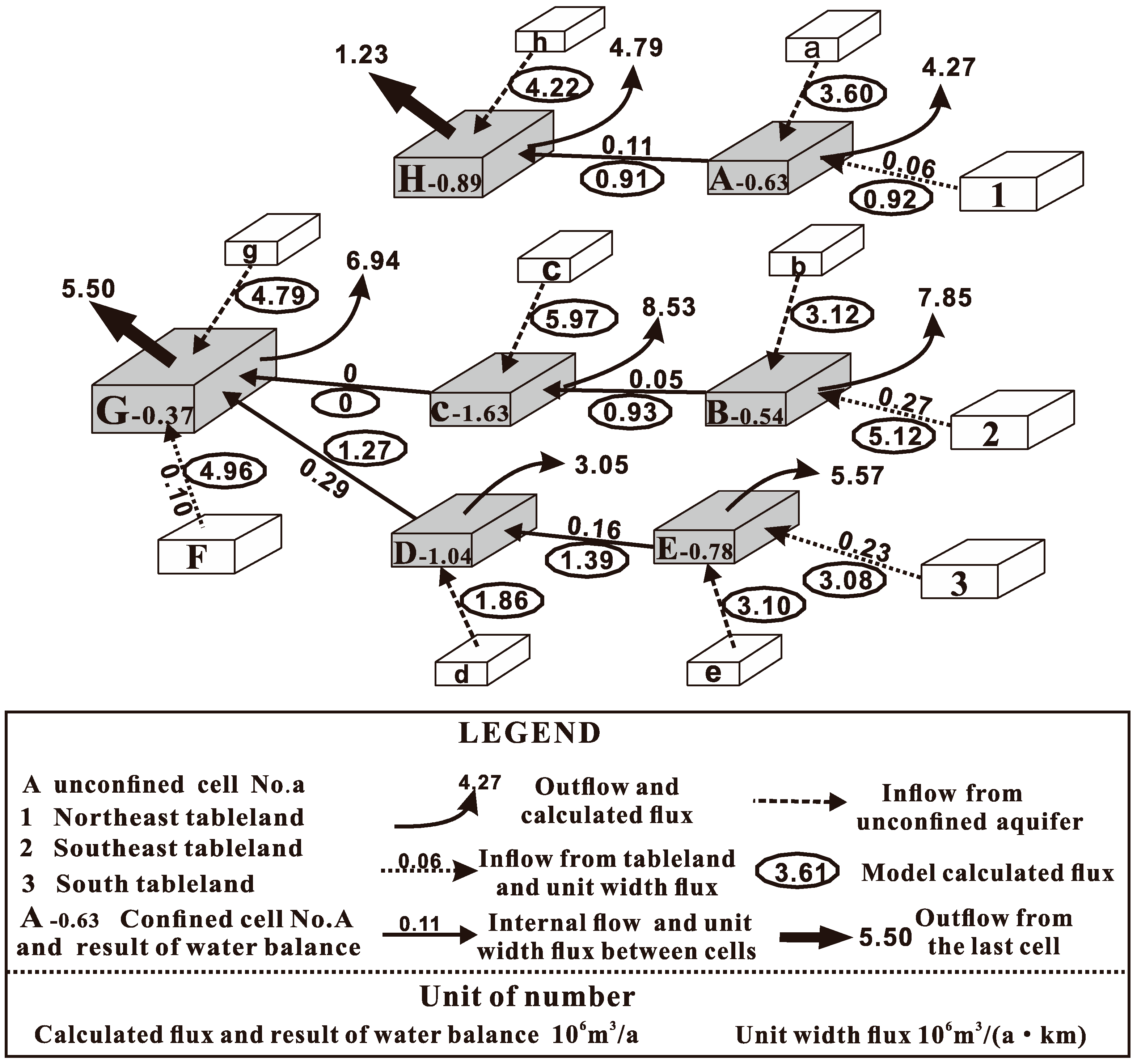
| Name | Constituent | K+ | Na+ | Ca2+ | Mg2+ | Cl− | SO42− | HCO3− | D | 18O |
|---|---|---|---|---|---|---|---|---|---|---|
| A | Average value | 0.08 | 5.35 | 4.22 | 5.05 | 4.35 | 3.92 | 5.43 | −63.15 | −8.04 |
| Square error | 0 | 9.68 | 1.68 | 2.19 | 2.68 | 2.72 | 3.89 | 11.8 | 1.79 | |
| B | Average value | 0.06 | 4.24 | 2.84 | 2.86 | 2.7 | 3.43 | 4.05 | −60.78 | −7.58 |
| Square error | 0 | 5.95 | 2.91 | 0.05 | 0.18 | 1.15 | 2.38 | 4.15 | 0.07 | |
| C | Average value | 0.082 | 4.41 | 4.65 | 3.52 | 2.53 | 3.29 | 5.98 | −67.17 | −8.57 |
| Square error | 0 | 1.47 | 1.03 | 0.11 | 0.46 | 0.56 | 0.16 | 8.59 | 0.01 | |
| D | Average value | 0.041 | 3.76 | 2.54 | 3.37 | 2.34 | 2.28 | 3.6 | −72.14 | −9.45 |
| Square error | 0 | 0.39 | 8.24 | 0.78 | 0.17 | 1.25 | 5.75 | / | / | |
| E | Average value | 0.07 | 4.51 | 3.88 | 4.11 | 2.41 | 2.97 | 6.41 | −67.33 | −7.38 |
| Square error | 0 | 0.09 | 3.83 | 8.02 | 0.55 | 2.34 | 5.82 | / | / | |
| G | Average value | 0.07 | 4.48 | 3.04 | 3.3 | 3.08 | 3.21 | 6.87 | −77.57 | −10.54 |
| Square error | 0 | 0.72 | 0.4 | 1.53 | 0.28 | 1.37 | 1.41 | / | / | |
| H | Average value | 0.07 | 5.32 | 4.01 | 5.2 | 3.58 | 4.12 | 5.81 | −73.26 | −9.15 |
| Square error | 0 | 0.81 | 3.94 | 0.69 | 0.02 | 2.3 | 0.78 | / | / | |
| a | Average value | 0.08 | 7.25 | 5.58 | 6.96 | 5.25 | 5.85 | 7.54 | −75.32 | −9.61 |
| Square error | 0 | 10.25 | 4.14 | 3.34 | 7.73 | 4.14 | 1.76 | 23.64 | 0.1 | |
| b | Average value | 0.07 | 6.91 | 3.25 | 4.5 | 5.98 | 6.07 | 3.17 | −66.57 | −7.96 |
| Square error | 0 | 0.02 | 1.29 | 2.08 | 7.86 | 0.13 | 0.21 | 4.14 | 0.22 | |
| c | Average value | 0.09 | 5.75 | 3.78 | 4.25 | 5.5 | 5.14 | 8.34 | −79.57 | −9.85 |
| Square error | 0 | 2.65 | 5.33 | 4.45 | 7.95 | 2.82 | 2.66 | 0.03 | 0.02 | |
| d | Average value | 0.06 | 6.31 | 4.81 | 3.08 | 3.14 | 3.5 | 7.69 | −79.06 | −10.16 |
| Square error | 0 | 5.38 | 1.28 | 3.73 | 0.76 | 1.94 | 8 | 23.77 | 1.41 | |
| e | Average value | 0.09 | 6.01 | 3.73 | 3.53 | 3.1 | 3.26 | 8.64 | −76.38 | −9.8 |
| Square error | 0 | 6.46 | 1.13 | 1.54 | 0.13 | 0.51 | 0.99 | / | / | |
| f | Average value | 0.09 | 3.34 | 4.11 | 3.34 | 2.26 | 2.78 | 5.86 | −80.94 | −10.96 |
| Square error | 0 | 0.76 | 2.95 | 2.58 | 0.22 | 0.87 | 3.04 | / | / | |
| g | Average value | 0.1 | 6.02 | 4.79 | 5.93 | 3.53 | 4.3 | 8.68 | −81.87 | −11.28 |
| Square error | 0 | 0.17 | 0.52 | 1.11 | 0.06 | 0.48 | 1.07 | / | / | |
| h | Average value | 0.09 | 5.71 | 5.18 | 5.92 | 4.75 | 4.15 | 8.9 | −80.05 | −10.51 |
| Square error | 0 | 19.43 | 2.69 | 3.41 | 12.06 | 2.92 | 4.51 | / | / | |
| Northeast tableland | Average value | 0.06 | 4.03 | 0.53 | 0.08 | 3.01 | 3.55 | 4.9 | −65.5 | −7.96 |
| Square error | 0 | 5.95 | 2.91 | 0.05 | 0.18 | 1.15 | 2.38 | 4.15 | 0.07 | |
| Southeast tableland | Average value | 0.03 | 3.19 | 0.89 | 2.13 | 2.36 | 2.8 | 4.19 | −62.28 | −8.65 |
| Square error | 0 | 0.17 | 0.52 | 1.11 | 0.06 | 0.48 | 1.07 | / | / | |
| South tableland | Average value | 0.07 | 4.21 | 5.7 | 4.56 | 2.54 | 3.4 | 6.26 | −65.61 | −9.83 |
| Square error | 0.02 | 4.33 | 0.78 | 0.06 | 2.21 | 3.05 | 3.9 | −58.72 | −6.95 |
| Cells | A | B | C | D | E | G | H |
|---|---|---|---|---|---|---|---|
| Area (km2) | 21.94 | 40.32 | 43.82 | 15.64 | 28.6 | 35.61 | 24.59 |
| Consumption (106 m3/a) | 4.27 | 7.85 | 8.53 | 3.05 | 5.57 | 6.94 | 4.79 |
| Cell Code | Width of Aquifer (km) | Thickness of Aquifer (m) | Hydraulic Conductivity (m/d) | Hydraulic Gradient | Consumption (106 m3/a) |
|---|---|---|---|---|---|
| H | 5.25 | 121.5 | 7.9 | 1/1500 | 1.23 |
| G | 8.5 | 14.6 | 1/1000 | 5.50 |
| Cells | A | B | C | D | E | G | H | Total | Proportion |
|---|---|---|---|---|---|---|---|---|---|
| Unconfined groundwater inflow | 3.60 | 3.12 | 5.97 | 1.86 | 3.1 | 4.78 | 4.22 | 26.65 | 65.43% |
| East tableland−inflow | 0.92 | 5.12 | 6.04 | 14.83% | |||||
| South tableland−inflow | 3.08 | 4.96 | 8.04 | 19.74% |
| Cells | A | B | C | D | E | G | H |
|---|---|---|---|---|---|---|---|
| Unconfined groundwater inflow (106 m3/a) | 3.60 | 3.12 | 5.97 | 1.86 | 3.10 | 4.78 | 4.22 |
| Area (km2) | 21.94 | 40.32 | 43.82 | 15.64 | 28.6 | 35.61 | 24.59 |
| Inflow of unit area (106 m3/a·km2) | 0.16 | 0.08 | 0.14 | 0.12 | 0.11 | 0.13 | 0.17 |
© 2016 by the authors; licensee MDPI, Basel, Switzerland. This article is an open access article distributed under the terms and conditions of the Creative Commons Attribution (CC-BY) license (http://creativecommons.org/licenses/by/4.0/).
Share and Cite
Wang, F.; Li, Q.; Liu, H.; Geng, X. Quantitative Analysis of Groundwater Recharge in an Arid Area, Northwest China. Water 2016, 8, 354. https://doi.org/10.3390/w8080354
Wang F, Li Q, Liu H, Geng X. Quantitative Analysis of Groundwater Recharge in an Arid Area, Northwest China. Water. 2016; 8(8):354. https://doi.org/10.3390/w8080354
Chicago/Turabian StyleWang, Fugang, Qinglin Li, Hongyan Liu, and Xinxin Geng. 2016. "Quantitative Analysis of Groundwater Recharge in an Arid Area, Northwest China" Water 8, no. 8: 354. https://doi.org/10.3390/w8080354





